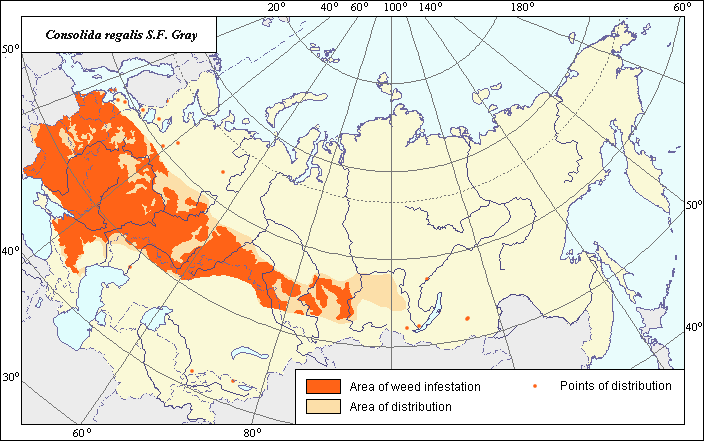Weeds
Area of distribution and weediness of Consolida regalis S.F. Gray.
 Object description Download GIS-layers
Object description Download GIS-layers
Authors:
Scientist - N.N. LunevaGIS-specialist - I.A. Budrevskaya.
Date of creation:
22.06.2004.Scale:
1:20,000,000.Accuracy of map:
Created based on information taken from open-published literature and maps of natural scale 1:13,000,000 - 1: 80,000,000.Projection:
"Alber's Equal Area Conic for the USSR" 9, 1001, 7, 100, 0, 44, 68, 0, 0.Basic contents:
Vector map. Area of distribution is shown by polygons (main distribution). Zone of weediness is shown by polygons.Accuracy of classifier:
Distribution of the species is divided into zones of main distribution, moderate weediness, and sporadic distribution areas.Method of map production:
Area and zone of weediness outlined according to results of the analysis of cartographic materials published in open literature. The map from Hulten & Fries (1986) demonstrating the presumable area was used as a basis; it was corrected according to literature data. The border of main distribution in the European part of the former USSR was specified according to Hulten & Fries (1986), supported by other references (Bakin et al., 2000; Grigor.evskaya , 2000; Ul.yanova, 1981, 1998; Maevskii. 1954; Nikitin, 1983; Rzhavitin, 1968). The southern border of distribution in Ciscaucasia was specified according to Galushko A.I. (1978) and coordinated with the limits of arable lands. The species distribution in Lower Volga Basin Region was also coordinated with the limits of arable lands. Its distribution from the Urals to Transbaikalia is supported by Volkov, 1935; Vasil.eva and Matsenko, 1964; Krasnoborov, 1979; Popov, 1957; Malyshev, 1993). The zone of weediness was outlined according to Nikitin V.V. (1983), and corrected according to data on abundance, occurrence and harmfulness of the weed; these data were taken from below-mentioned references (except Keys and Floras) and were coordinated with the limits of grain-growing lands which suffer most of all from the weed. Patches of sporadic distribution were based on literature data (Hulten & Fries, 1986; Volkov, 1935).Reference citations:
Bakin O.V., Rogova T.V., Sitnikova A.P. 2000. Vascular plants of Tatarstan. Kazan: Kazan University. 496 pp. (in Russian).Galushko A.I. 1978. Flora of the Northern Caucasus. V. 1. Rostov-na-Donu: Rostov University, 316 pp. (in Russian).
Grigor.evskaya A.Ya. 2000. Flora of Voronezh town. Voronezh: Voronezh University. 198 pp. (in Russian).
Krasnoborov I.M., Kashina L.I. 1979. Keys to plants of southern Krasnoyarsk Territory. Novosibirsk: Nauka. 670 pp. (in Russian).
Maevskii P.F. 1954. Flora of middle belt of the European part of the USSR. Moscow & Leningrad: Selkhozgiz. 912 pp. (in Russian).
Nikitin V.V. 1983. Weeds in the flora of the USSR. Leningrad: Nauka. 454 pp. (in Russian).
Popov M.G. 1957. Flora of Middle Siberia. V. 1. Moscow & Leningrad: AS USSR, 556 pp. (in Russian).
Rzhavitin V.N., ed. 1968. Flora of Mordovian ASSR. Saransk: Mordovian Publishing House, 138 pp. (in Russian).
Ulyanova T.N. 1981. Weed plants in wheat of the USSR. In: Korovina, O.N., ed. Catalogue of VIR world collection. N 320. Leningrad: VIR, 68 pp. (in Russian).
Ulyanova T.N., 1998. Weeds in the flora of Russia and other CIS states. St.Petersburg: VIR. 344 pp. (in Russian).
Vasileva L.I. & Matsenko A.E. 1964. Keys to weed plants of the Virgin Lands. Moscow & Leningrad: Nauka, 132 pp. (in Russian).
Right and copyright:
All rights reserved. Copyright 2004© N.N.Luneva & I.A.Budrevskaya.N.N.Luneva is the author of image (VIZR).

